FHWA-HIN-21-001
February 2021

Notice: This document is disseminated under the sponsorship of the U.S. Department of Transportation in the interest of information exchange. The U.S. Government assumes no liability for the use of the information contained in this document. The U.S. Government does not endorse products or manufacturers. Trademarks or manufacturers' names appear in this document only because they are considered essential to the objective of the document.
Quality Assurance Statement: The Federal Highway Administration (FHWA) provides high-quality information to serve Government, industry, and the public in a manner that promotes public understanding. Standards and policies are used to ensure and maximize the quality, objectivity, utility, and integrity of its information. FHWA periodically reviews quality issues and adjusts its programs and processes to ensure continuous quality improvement.
Researchers: This study was performed by the USDA, pursuant to Contract DTFH6814X00138A.
| 1. Report No. FHWA-HIN-21-001 |
2. Government Accession No. | 3. Recipient's Catalog No. | ||||
| 4. Title and Subtitle Unsurfaced Road Stabilization Using Paper Mill Boiler Ash |
5. Report Date Feb. 8, 2021 |
|||||
| 6. Performing Organization Code | ||||||
| 7. Author(s) Andrea Kirk |
8. Performing Organization Report No. | |||||
| 9. Performing Organization Name and Address USDA-USFS |
10. Work Unit No. (TRAIS) | |||||
| 11. Contract or Grant No. DTFH6814X00138A |
||||||
| 12. Sponsoring Agency Name and Address FHWA Office of Technical Services 1200 New Jersey Ave. SE Washington D.C. 20590 |
13. Type of Report and Period Covered Technical Brief |
|||||
| 14. Sponsoring Agency Code | ||||||
| 15. Supplementary Notes COTR: Amit Armstrong, Ph.D., P.E. This technology deployment was funded under the FHWA Federal Lands Highway Coordinated Technology Implementation Program (CTIP). |
||||||
| 16. Abstract Overview of process for applying paper mill boiler ash to unsurfaced roads. |
||||||
| 17. Key Words Unsurfaced Roads, Surfaced Roads, Pavement, Stabilization, Construction |
18. Distribution Statement No restrictions. This document is available to the public through the National Technical Information Service, Springfield, VA 22161. http://www.ntis.gov |
|||||
| 19. Security Classif. (of this report) Unclassified |
20. Security Classif. (of this page) Unclassified |
21. No. of Pages | 22. Price | |||
Form DOT F 1700.7 (8-72)
Reproduction of completed page authorized
| Symbol | When You Know | Multiply By | To Find | Symbol |
|---|---|---|---|---|
| LENGTH | ||||
| in | inches | 25.4 | millimeters | mm |
| ft | feet | 0.305 | meters | m |
| yd | yards | 0.914 | meters | m |
| mi | miles | 1.61 | kilometers | km |
| AREA | ||||
| in2 | square inches | 645.2 | square millimeters | mm2 |
| ft2 | square feet | 0.093 | square meters | m2 |
| yd2 | square yard | 0.836 | square meters | m2 |
| ac | acres | 0.405 | hectares | ha |
| mi2 | square miles | 2.59 | square kilometers | km2 |
| VOLUME | ||||
| fl oz | fluid ounces | 29.57 | milliliters | mL |
| gal | gallons | 3.785 | liters | L |
| ft3 | cubic feet | 0.028 | cubic meters | m3 |
| yd3 | cubic yards | 0.765 | cubic meters NOTE: volumes greater than 1000 L shall be shown in m3 |
m3 |
| MASS | ||||
| oz | ounces | 28.35 | grams | g |
| lb | pounds | 0.454 | kilograms | kg |
| T | short tons (2000 lb) | 0.907 | megagrams (or "metric ton") | Mg (or "t") |
| TEMPERATURE (exact degrees) | ||||
| °F | Fahrenheit | 5 (F-32)/9 or (F-32)/1.8 | Celsius | °C |
| ILLUMINATION | ||||
| fc | foot-candles | 10.76 | lux | lx |
| fl | foot-Lamberts | 3.426 | candela/m2 | cd/m2 |
| FORCE and PRESSURE or STRESS | ||||
| lbf | poundforce | 4.45 | newtons | N |
| lbf/in2 | poundforce per square inch | 6.89 | kilopascals | kPa |
| Symbol | When You Know | Multiply By | To Find | Symbol |
|---|---|---|---|---|
| LENGTH | ||||
| mm | millimeters | 0.039 | inches | in |
| m | meters | 3.28 | feet | ft |
| m | meters | 1.09 | yards | yd |
| km | kilometers | 0.621 | miles | mi |
| AREA | ||||
| mm2 | square millimeters | 0.0016 | square inches | in2 |
| m2 | square meters | 10.764 | square feet | ft2 |
| m2 | square meters | 1.195 | square yards | yd2 |
| ha | hectares | 2.47 | acres | ac |
| km2 | square kilometers | 0.386 | square miles | mi2 |
| VOLUME | ||||
| mL | milliliters | 0.034 | fluid ounces | fl oz |
| L | liters | 0.264 | gallons | gal |
| m3 | cubic meters | 35.314 | cubic feet | ft3 |
| m3 | cubic meters | 1.307 | cubic yards | yd3 |
| MASS | ||||
| g | grams | 0.035 | ounces | oz |
| kg | kilograms | 2.202 | pounds | lb |
| Mg (or "t") | megagrams (or "metric ton") | 1.103 | short tons (2000 lb) | T |
| TEMPERATURE (exact degrees) | ||||
| °C | Celsius | 1.8C+32 | Fahrenheit | °F |
| ILLUMINATION | ||||
| lx | lux | 0.0929 | foot-candles | fc |
| cd/m2 | candela/m2 | 0.2919 | foot-Lamberts | fl |
| FORCE and PRESSURE or STRESS | ||||
| N | newtons | 0.225 | poundforce | lbf |
| kPa | kilopascals | 0.145 | poundforce per square inch | lbf/in2 |
*SI is the symbol for the International System of Units. Appropriate rounding should be made to comply with Section 4 of ASTM E380.
(Revised March 2003)
The objective of this project was to determine the effectiveness of paper mill byproduct as a successful road stabilizer.
Unsurfaced roads may seem quaint and nostalgic, but they aren't always the romantic escape you hear about in country songs. They can present unique and costly maintenance problems that financially strapped transportation agencies do not have the funds to tackle.
In the U.S., roughly thirty-five percent, or 1,715,000 miles, of roads are unpaved and a familiar sight in rural communities. These roads serve as the daily commuting route for rural residents, means of getting agricultural products in and out of farm fields, timber out of forests, or as access to remote areas such as campgrounds and lakes. The condition of these roads impacts the safety and quality of life in rural America. Rural transportation agencies with limited funds at their disposal are typically responsible for the maintenance of these roads. These rural transportation agencies cannot afford the burden of continually stabilizing unsurfaced roads with expensive gravel and aggregate. Many leave these roads unpaved due to low traffic volume and/or lack of funds to adequately improve the subgrade and base. Surface deterioration is a continuous battle and traditional stabilization methods can be out of reach for many transportation agencies budgets.
Although nationally the percentage of fatalities and serious injuries are low on unpaved roads, in some states these roadways account for up to 20 percent of the fatalities. Adding to safety concerns is the challenging problem of erosion which can shorten the life of maintenance improvements, increase concerns for water quality of lakes and streams, and cause surface and slope deterioration. The maintenance of these roads can be both costly and difficult, and the challenge is even greater when factoring in traffic loads, condition of subgrade soils, quality of construction materials and practices, and general maintenance techniques. Many agencies face the public's desire to preserve the unblemished natural character of rural areas.
Unpaved roads are an integral and strategic part of the national road network and successfully function for years when properly constructed and maintained. But they don't stand up to traffic without some occasional maintenance; therefore, light, regular re-grading and less frequent but more intensive gravel replacement, reshaping, and stabilization should all be part of a planned maintenance program. For many unpaved roads, identifying a suitable and cost-efficient stabilization material can be a good economic decision by reducing material loss and the need for blade maintenance. The most common material used to stabilize unpaved roads is gravel. In some rural areas, gravel can be expensive or in short supply if the local area geology does not include natural gravel deposits. Many rural agencies need effective "substitutes" to stabilize their low-volume roads.
Stabilizing unpaved roads and controlling dust is becoming a high priority as maintenance budgets experience stagnation, environmental concerns become more prevalent, and as quality road building materials are depleted and harder to procure. The U.S. Forest Service, like many other rural agencies, needed to find ways to stretch its maintenance dollars and extend the life of its 380,000 miles of unpaved roads.
Many chemical treatments can be used to overcome limitations in material properties and stabilize unpaved roads and are continuously being introduced to the market. The Forest Service was looking for a cost-effective solution and research revealed that paper mill boiler ash, an industrial byproduct, had application in unpaved road stabilization. When this byproduct was used to stabilize roads in Europe, the following benefits were realized: less frequent occurrence of cracks, unevenness and potholes.
Paper mill boiler ash is dry ash produced by the combustion of woodchips, chunk wood, sawdust, and bark (biomass) for energy generation. This wood fuel ash is typically high in unburned carbon, magnesium and calcium and has a relatively high pH. The primarily granular nature and mineral composition of paper mill boiler ash make it a good candidate for road stabilization.
Boiler ash producers must dispose of this industrial byproduct. This disposal can represent a significant cost to the organization, and repurposing is a cost-effective alternative to disposal. Many states encourage and support the re-use of industrial byproduct as a means of reducing the volume of landfill solid waste. Beneficial reuse of industrial byproducts is a major goal for both industry and environmental regulators.
Unstable sands occur locally in places such as streambeds and washes. Wide regions of the United States, however, are covered predominantly by unstable sand (see discussion of geographic extent of sands under Nature and Extent of Unstable Sands). Because of the predominance of sand deposits, these areas tend to lack gravel, which is the most typical road-stabilization material due to its strength and interlocking behavior when well graded. Thus, FLMAs need cost-effective alternative road-stabilizing materials and techniques for such roads.
To demonstrate the use of boiler ash, the Forest Service chose to stabilize two one-mile road segments in the Chequamegon-Nicolet National Forest, which is part of the northern Great Lakes region. The site was selected because it had unstable sand roads previously treated unsuccessfully with other stabilization materials such as chunk wood and woodchips and there was an active paper mill nearby. The low volume roads at this site are composed of naturally occurring sands. Roads built using these native materials typically are far less navigable, especially after rains. The sand ruts and requires constant grading and repair. In the Chequamegon-Nicolet National Forest, obtaining good quality gravel to stabilize the sands is prohibitively expensive because it requires long distance hauling.
The boiler ash byproduct was sourced from the Flambeau Papers Mill in Park Falls, Wisconsin. Flambeau River Papers had an approval from Wisconsin Department of Natural Resources (WDNR) to distribute their boiler ash, but the end-user was also required to obtain clearance for the specific use. In order to use this type of material as a road stabilizer in the national forest, the Forest Service needed to obtain environmental clearance and permitting from the WDNR.
Paper mill byproduct is not regulated under the Resource Conservation and Recovery Act (RCRA) unless it contains residuals regulated in accordance with 40 CFR Part 261. Material Safety Data Sheets and periodic testing required by state conservation officials will determine if the boiler ash contains properties that define it as a hazardous waste. Boiler ash is normally considered benign and has essentially the same properties as naturally occurring ash from forest fires. However, the direct application of industrial byproducts such as paper mill boiler ash to land is regulated by each state natural resource or conservation agency. Industrial wastes with beneficial uses are classified as commercial, even if they cannot be sold. States often permit and encourage the reuse of industrial byproducts that are non-hazardous and can be safely used. The Forest Service worked with the Wisconsin Dept. of Natural Resources to obtain permission for the application of boiler ash. The State of Wisconsin has an established policy that addresses the beneficial use of industrial byproducts (Wisconsin Administrative Code 2013). Pursuant to this policy, the Wisconsin Department of Natural Resources allowed land application of each of these materials (sludge, ash, lignosulfonates, and lime grit), subject to certain limitations and monitoring, from the Flambeau River Papers mill in Park Falls, WI (WDNR 2002).
Soil characteristics of the two road segments included:
Prior to application of the boiler ash, the pH, toxicity, and leachability of trace constituents, such as certain organics and heavy metals, must be assessed. In May 2013, the Forest Service excavated test pits and collected samples. Staff compiled samples of stock piled chunk wood, paper mill sludge, paper mill boiler ash, and lignosulfate material. The chunk wood was produced in 2010 from the onsite prototype chunker. The Flambeau Paper Mill provided samples and Forest Service staff delivered the samples to a geotechnical lab for physical testing of engineering properties. The physical testing of engineering properties included grain size distribution, grain regularity, moisture content, organic content, pH, plasticity, compaction, bearing and compressibility. Paper mill boiler ash qualifies as silty sand when tested as a soil.
Once engineering properties were tested, Forest Service personnel and their contractors completed the following: conducted falling weight deflectometer (FWD) testing on the road grades at about 0.1-mile intervals; cleared vegetation, graded, and shaped the road prism; conducted dynamic cone penetrometer (DCP) testing on the cleared road grade at about 0.1-mile intervals; and tested the maximum density and optimum moisture content and California bearing ratio (CBR) for the untreated road grade soils. The Wisconsin Department of Transportation (WDOT) conducted FWD tests on both roads in July 2015 before initial road grading. Forest Service personnel and the construction contractor's geotechnical engineering lab (Coleman Engineering) conducted DCP testing (ASTM D 6951) after the initial road grading but before boiler ash treatment. In addition to FWD and DCP testing, the construction contractor's geotechnical engineering lab conducted basic compaction testing using a nuclear density gauge (ASTM D 6938) as part of normal construction quality control to ensure at least 90 percent relative compaction of the ash-soil blends.
Once testing was complete, Forest Service personnel used a dump truck and a loader (tractor with a bucket) to spread boiler ash on the road grade. It was blended with the upper 3 in. (7.6 cm) of soil at the following proportions:
When necessary, a water truck was used to adjust soil moisture content.
Photo Credits: U.S. Forest Service
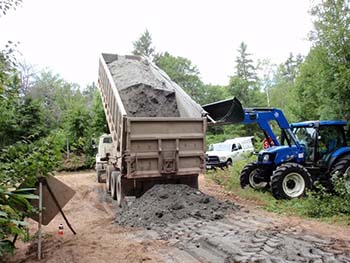
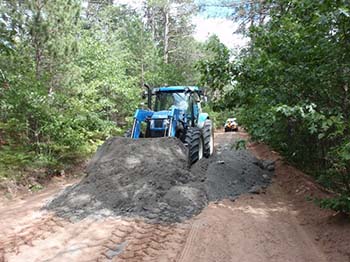
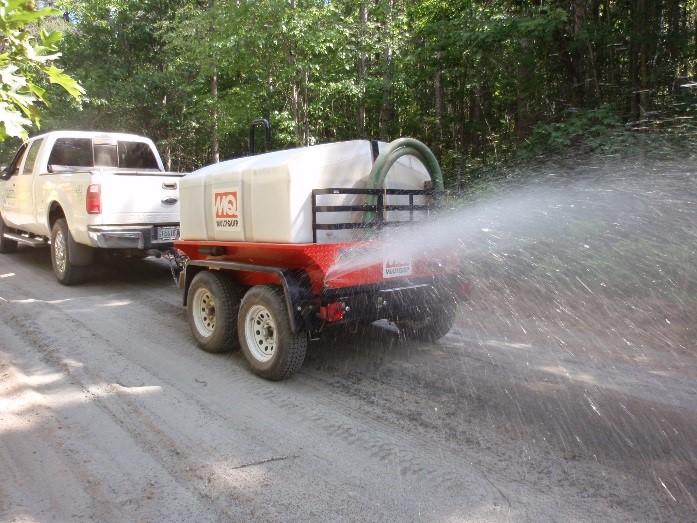
The ash was blended with the soil using an agricultural disk (five to six roundtrips, 10 to 12 passes) to achieve an approximately 6-in. thick (15-cm) ash-soil treated zone. Once the ash and soil were blended, the maximum density and CBR of the mixture was tested. After determining satisfactory density and CBR, the road was shaped with a grader. Once the road had been graded and shaped, dynamic cone penetrometer (DCP) testing was conducted on the cleared road grade at approximately 0.1-mile intervals. After the DCP testing was completed, the mixture was compacted using a vibratory smooth drum roller. The blended ash-soil compacted grade was tested to verify at least 90% of maximum dry density (approximately four passes with vibration and four passes in static mode).
Photo Credits: U.S. Forest Service
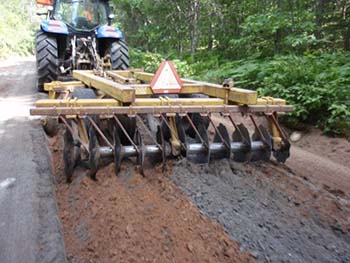
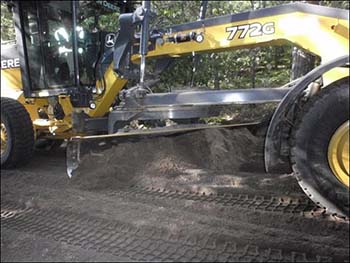
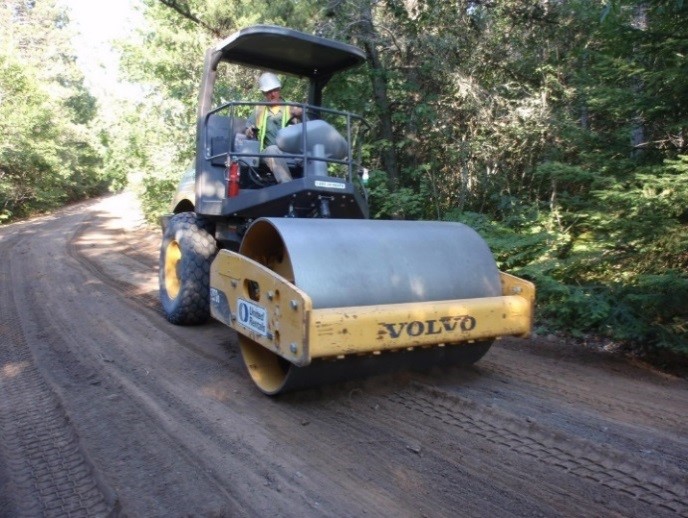
After the mixture was blended and compacted, Forest Service personnel conducted DCP testing and FWD testing on the treated and compacted road grades at 0.1-mi (0.2-km) intervals. Road cross-sections at 0.1-mi (0.2-km) intervals were surveyed to provide a baseline for future rutting or settlement of the road sections. Automatic traffic counters were installed to evaluate the impacts of ADT on the augmented sites. One year after application, Forest Service personnel again conducted DCP and FWD testing and re-surveyed cross-sections on the treated and compacted road grades at 0.1-mi (0.2-km) intervals.
FWD test results from the siltier of the two roads (FR 1155) showed improved stiffness immediately after treatment and still more improvement 1 year later. FWD test results on the road with the sugar sand soil (FR 685) indicated a softer road subgrade for the test event shortly after boiler ash treatment (September 2015) than the test event before initial grading (July 2015), but then stiffer than initial conditions a year later (August 2016). This temporary loss of stiffness may be more a function of soil moisture from rain events than a function of the road grading, ash treatment, and compaction. Or it may be that scarification and treatment with boiler ash loosened the soil somewhat compared to the initial condition of the roads despite compaction after applying ash. The subsequent subgrade stiffening shown in the 2016 data a year later may reflect curing of the cementitious elements in the boiler ash and settlement or compaction of the soil from traffic and weather.
The two demonstration roads were monitored for a period of one year to evaluate their performance through a full winter, spring, and summer driving season. The low volume roads carried average daily traffic (ADT) of less than 10 vehicles per day, but on the silty sand road (FR1155) that included heavy trucks from a timber harvest. Road users reported some "slickness" to the ash treated roads when wet, but otherwise were pleased with the road performance. The silty sand road (FR1155) exhibited some rutting but the sandy road (FR685) showed negligible changes to the road shape. The performance of the road with a poorly graded "sugar sand" subgrade appeared to benefit significantly from ash stabilization, while the road with a silty sand/ loam subgrade performed adequately but did not appear to benefit significantly from the ash treatment. The difference is likely due to the fact that the sand soil on FR685 lacked the binder provided by the ash and the siltier soil on FR1155 had sufficient binder and did not derive the same benefits from the application.
Graphics: U.S. Forest Service


FR685 demonstrated the most benefit from the boiler ash treatment. The soil on FR685 was very sandy ("sugar sand") with properties like beach sand or sandbox sand. Prior to the application of the boiler ash, there were severe traction problems on this road. After boiler ash treatment, the traction and stability of FR685 improved noticeably. The boiler ash treatment almost eliminated the extreme rutting that was present. The road maintained its shape over the 1-year test period, which included a full winter freeze, spring thaw, and summer traffic.
Photo Credits: U.S. Forest Service
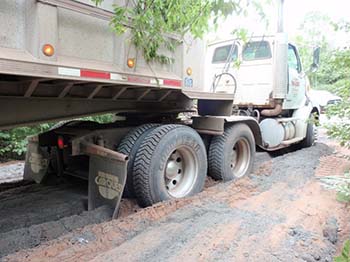
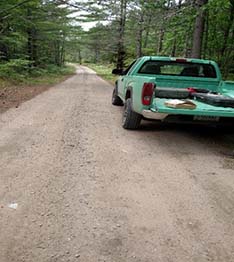
As shown in Table 1 below, the cost of stabilizing these two low volume roads using boiler ash was found to be less and highly dependent on haul/delivery cost of materials. The table shows actual project costs for the boiler ash demonstration roads and comparable hypothetical values for what gravel surfacing would have cost on the same Forest Service roads:
Table 1 shows actual project costs for the boiler ash treatments using 400 cubic yards (yd3) of material for each road and hypothetical cost estimates for gravel surfacing treatments using 1,500 yd3 of material for each road for comparison. The estimated cost difference between boiler ash and gravel treatments was 57 percent—the boiler ash treatment had a lower cost. All costs are in U.S. dollars.
| Item | FR1155 Boiler Ash | FR1155 Gravel Surfacing | FR685 Boiler Ash | FR685 Gravel Surfacing (3") |
|---|---|---|---|---|
| Actual Costs (400 CY ash) |
Hypothetical Costs (1500 CY gravel) |
Actual Costs (400 CY ash) |
Hypothetical Costs (1500 CY gravel) |
|
| Purchase material | $0 | $15,000 | $0 | $15,000 |
| Haul/deliver to site | $15,000 | $8,000 | $9,720 | $23,000 |
| Shape and prep road bed | $6,100 | $6,100 | $6,100 | $6,100 |
| Spread and compact material (for boiler ash this includes blending) | $12,100 | $12,100 | $12,100 | $7,500 |
| Total Cost Per Lane Mile | $33,200 | $36,600 | $27,920 | $51,600 |
| Total Cost Per Lane Mile Less Hauling Costs | $18,200 | $28,600 | $18,200 | $28,600 |
The following are the general steps to take when implementing boiler ash stabilization:
Paper mill boiler ash is an effective road stabilization material under certain conditions. As evidenced by the monitoring of the two demonstration sites, the nature of the soil, especially its level of silt and elasticity, can impact the effectiveness of the treatment. The application of paper mill boiler ash delivers the best result when it is used on predominantly sandy, rather than silty sandy, soils. The application of paper mill boiler ash to the predominantly sandy road significantly enhanced the road stability and was still performing as intended two years after application.
If your site has this type of soil, and there is an established timber industry in your area, paper mill boiler ash is a cost-effective alternative to gravel or aggregate. The use of the ash for land applications may be restricted by your state environmental authorities, so it is imperative to seek regulatory approval prior to making any final decisions. If the use of this industrial byproduct is allowed in your state for your purposes, the permitting and approval process should be relatively straightforward.
Although more expensive techniques using equipment such as pulverizers and pugmills can result in highly refined, uniform, well processed subgrades, the construction methods for road stabilization boiler ash can be very simple and conventional. The demonstration projects described in this Tech Brief used only a loader, grader, water truck, and vibrating compaction roller. The application of the boiler ash to the roads does not require complex equipment and can be performed with significantly less capital expenditure than that of a stabilization using gravel or aggregate. Regular monitoring and re-application of the boiler ash every few years will produce more dependable and reliable results.
Question: How many paper mills are there in the United States?
Answer: Currently there are 360 paper mills in 40 States. The top ten States with the most paper mills are AL, GA, LA, SC, VA, WA, OR, WI, MI, and ME. https://en.wikipedia.org/wiki/List_of_paper_mills#United_States
Question: How much paper mill boiler ash is available?
Answer: Approximately 4 million dry tons annually.
Question: How many tons of paper mill boiler ash did the USFS use for this demonstration?
Answer: 1,200 tons were placed for this two-mile treatment.
Question: Is boiler ash usually free?
Answer: Yes. Giving it away saves the facility the cost of disposal.
Question: How long between treatments will my road remain stable?
Answer: Routine maintenance and monitoring are required for continued stability. Reapplication may be necessary every few years.
Question: Will I be able to perform light maintenance on boiler ash treated roads?
Answer: Since a treated surface forms into a loosely bound crust, typical road grading is still effective. Rewetting and re-compacting after the grading operation should restore the treated road's stability.
Arm, M.; Vestin, J.; Lind, B.; Lagerkvist, A.; Nordmark, D.; Hallgren, Per. 2014. Pulp mill fly ash for stabilization of low-volume unpaved forest roads - field performance. Canadian Journal of Civil Engineering, Vol. 41: 955-963. http://www.nrcresearchpress.com/doi/abs/10.1139/cjce-2014-0030
Bird, M.; Talberth, J. 2008. Waste stream reduction and re-use in the pulp and paper sector, Washington State Department of Ecology, Industrial Footprint Project, Project Task 5.1. Santa Fe, NM: Center for Sustainable Economy.
Finnish Road Administration (Finnra). 2001. Fly ash mixtures as flexible structural materials for low-volume roads. Finnra Reports 70/2001. Helsinki, Finland. 95 p.
Finnish Road Enterprise. 2004. Environmentally friendly systems to renovate secondary roads - demonstration project in Luopioinen, Finland. Project summary. http://ec.europa.eu/environment/life/project/Projects/index.cfm?fuseaction=search.dspPage&n_proj_id=2131&docType=pdf
Kaakkurivaara, T.; Vuorimies, N.; Kolisoja, P.; Uusitalo, J.; 2015. Applicability of portable tools in assessing the bearing capacity of forest roads. Silva Fennica, Volume 49, No. 2, article ID 1239, 26p.
Kaakkurivaara, T.; Kolisoja, P.; Uusitalo, J.; Vuorimies, N. 2016. Fly ash in forest road rehabilitation. Croatian Journal of Forest Engineering, Volume 37 No. 1, pp 119-130. www.crojfe.com/r/i/crojfe_37-1_2016/Kaakkurivaara.pdf
National Council for Air and Stream Improvements (NCASI). 1999. A summary of available data on the chemical composition of forest products industry solid wastes. Special Report No. 99-04. Gainesville, FL: NCASI. 54 p.
Obernberger, I.; Supanicic, K. 2009. Possibilities of ash utilization from biomass combustion plants. In: ETA-Renewable Energies, ed. Proceedings of the 17th European Biomass Conference & Exhibition, June/July 2009, Hamburg, Germany.
Russell, M. 2016. Stabilizing sand roads using wood fiber material and byproducts; A survey of material alternatives and performance of past projects. Technical Report 1577-1805-SDTDC. San Dimas, CA: U.S. Department of Agriculture, Forest Service, San Dimas Technology and Development Center, 112 p. - DRAFT, In publication. http://fsweb.mtdc.wo.fs.fed.us/php/library_card.php?p_num=1577%201805
Supancic, K.; Obernberger, I. 2012. Wood ash utilisation as a stabiliser in road construction—first results of large-scale tests. ASH 2012. Stockholm, Sweden: Svebio, SBSAB, Bioenergi & Bioenergy International. [8] p.
Vestin, J.; Arm, M.; Nordmark, D.; Lagerkvist, A.; Hallgren, P.; Lind, B. 2012. Fly ash as a road construction material. In: Arm, M.; Vandecasteele, C.; Heynen, J.; Suer, P.; Lind, B., eds. WASCON 2012 Conference proceedings. Gothenburg, Sweden: Swedish Geotech-nical Institute: 8 p.
Zhou, H.; Smith, D.W.; Sego, D.C. 2000. Characterization and use of pulp mill fly ash and lime by-products as road construction amendments. Canadian Journal of Civil Engineering. 27(3): 581-593. http://www.nrcresearchpress.com/doi/abs/10.1139/l99-081#.V8dm45hf1aQ